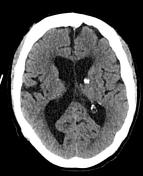Search results for “multiple sclerosis”
31 results found
Article
Multicystic dysplastic kidney
Multicystic dysplastic kidney (MCDK) is a type of non-heritable pediatric cystic renal disease. It results in multiple cysts being formed in utero in the affected kidney.
Epidemiology
Unilateral incidence is estimated at 1:2500-4000. There may be a predisposition for the left kidney, a slightl...
Article
Renal angiomyolipoma
Renal angiomyolipomas (AML) are a type of benign renal neoplasm encountered both sporadically and as part of a phakomatosis, most commonly tuberous sclerosis. They are considered one of a number of tumors with perivascular epithelioid cellular differentiation (PEComas) and are composed of vascul...
Article
Neurogenic bladder
Neurogenic bladder is a term applied to a dysfunctional urinary bladder that results from any lack of coordination between the central nervous system and the somatic nervous system 1, including injuries to the central or peripheral nerves that control and regulate urination. Injury to the brain,...
Case
Tuberous sclerosis - multiple angiomyolipomas

Published
01 Mar 2010
98% complete
CT
Article
Tuberous sclerosis (diagnostic criteria)
The tuberous sclerosis diagnostic criteria have been developed to aid the diagnosis of tuberous sclerosis and have been updated in 2012 by the International Tuberous Sclerosis Complex Consensus Group (at time of writing - 2019) 1.
Diagnosis
Genetic criteria
The identification of either a TSC...
Article
Renal osteodystrophy
Renal osteodystrophy, also known as uremic osteopathy, is a constellation of musculoskeletal abnormalities that occur in patients with chronic renal failure, due to concurrent and superimposed:
osteomalacia (adults) or rickets (children)
secondary hyperparathyroidism: abnormal calcium and phos...
Case
Complications of sickle cell disease

Published
25 Sep 2023
93% complete
CT
X-ray
Fluoroscopy
Article
Tuberous sclerosis
Tuberous sclerosis (TS), also known as tuberous sclerosis complex (TSC) or Bourneville disease, is a phakomatosis (neurocutaneous disorder) characterized by the development of multiple benign tumors of the embryonic ectoderm (e.g. skin, eyes, and nervous system).
Epidemiology
Tuberous sclerosi...
Article
Nephrotic syndrome
Nephrotic syndrome results from loss of plasma proteins in the urine and characterized by hypoalbuminemia, hyperalbuminuria, hyperlipidemia, and edema. It may be caused by primary (idiopathic) renal disease or by a variety of secondary causes.
Clinical presentation
Patients present with marked...
Article
Erectile dysfunction
Erectile dysfunction is a common condition. Doppler ultrasound is a highly accurate means of assessing patients with erectile dysfunction.
Pathology
Psychological factors (mental impulse) cause the transmission of parasympathetic impulses to the penis. This causes relaxation of arterioles and...
Article
Glomerulocystic kidney disease
Glomerulocystic kidney disease (GCKD) is a rare cystic kidney disease.
Epidemiology
Associations
Following syndromic associations have been proposed 4:
Down syndrome
asplenia with cardiovascular anomalies
multiple acyl-CoA dehydrogenase deficiency
Jeune syndrome
Marden-Walker syndrome
...
Case
Tuberous sclerosis - multiple angiomyolipomas

Published
17 Sep 2018
77% complete
CT
Article
Pheochromocytoma
Pheochromocytomas are an uncommon tumor of the adrenal gland, with characteristic clinical, and to a lesser degree, imaging features. The tumors are said to follow a 10% rule:
~10% are extra-adrenal
~10% are bilateral
~10% are malignant
~10% are found in children
~10% are not associated wit...
Case
Wunderlich syndrome - angiomyolipoma rupture in tuberous sclerosis

Published
11 Jan 2018
95% complete
CT
Photo
Case
Tuberous sclerosis with renal angiomyolipomas

Published
28 Jul 2022
92% complete
CT
Case
Tuberous sclerosis

Published
13 Nov 2018
95% complete
Ultrasound
CT
MRI
Article
Bilateral renal enlargement
Bilateral renal enlargement, also known as nephromegaly, can arise from many causes including 1,2:
Smooth enlargement
diabetic nephropathy (common)
acute pyelonephritis
renal involvement with lymphoma
acute interstitial nephritis
acute glomerulonephritis
acute urate nephropathy
vasculiti...
Case
Bladder calculi

Published
24 Jun 2020
88% complete
X-ray
Case
Paraneoplastic tumefactive demyelination

Published
28 Feb 2018
74% complete
MRI
CT
Ultrasound
Article
Renal oncocytoma
Renal oncocytomas are relatively benign renal tumors. The main clinical importance of this lesion is the difficulty in preoperatively distinguishing it from renal cell carcinomas, as epidemiology, presentation, imaging and even histology can be very similar.
Epidemiology
Renal oncocytomas acc...









 Unable to process the form. Check for errors and try again.
Unable to process the form. Check for errors and try again.